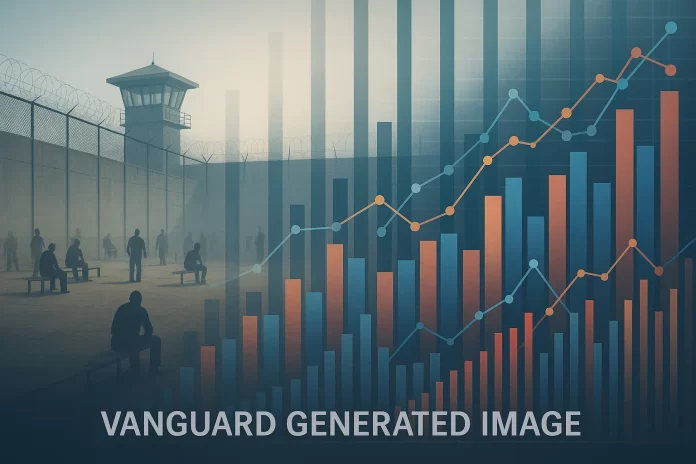
- “We are thrilled about the ability to really evaluate the effects of policy reforms… The data now also allows us to ask policy evaluation questions.” – Mia Bird, Assistant Professor of Public Policy at UC Berkeley
BERKELEY, CA – The California Policy Lab, in partnership with the state’s Committee on the Revision of the Penal Code, has released a groundbreaking public resource: the California Prison Population Data Dashboards.
The dashboards, available at www.californiaprisondata.org, provide interactive access to ten years of data about California’s state prison population, including detailed breakdowns by race, gender, age, offense type, and county of conviction.
According to Michael Romano, chairperson of the Committee on the Revision of the Penal Code, “For the first time, lawyers, policy-makers, and the general public can see detailed information about who goes to prison, for which crimes, for how long, and from which counties. That creates a much more granular level of detail than was historically available to the public.”
The project reflects years of work by researchers seeking to make criminal justice data more accessible and transparent. The dashboards draw directly from the California Department of Corrections and Rehabilitation (CDCR) and are updated semiannually to include new data on admissions, releases, and current populations.
Mia Bird, Assistant Professor of Public Policy at UC Berkeley and a lead researcher on the project, told the Vanguard in an interview that before the dashboards, accessing CDCR data required either formal public records requests or specialized analytical software.
“What we’re trying to do is improve access to that data,” Bird said. “There are so many stakeholders—policymakers, researchers, journalists, county governments, nonprofits, advocates, and people who just want to know who’s in prison and for how long. The idea of the dashboard is to give people access to explore the data in the way they want to, without having that high bar of having to request the data and have those software capacities.”
The dashboards include three interactive frames: current population, admissions since 2015, and releases since 2015. Users can view information such as offense categories, strike enhancements, average sentence lengths, and demographic distributions.
The site also features twelve charts on commonly used sentence enhancements, allowing for analysis of how policies like gang enhancements or the “nickel prior” have changed over time.
Bird said the project grew from a partnership between the California Policy Lab, based at UC Berkeley and UCLA, and the Committee on the Revision of the Penal Code, created under Governor Gavin Newsom.
“The committee is really tasked with exploring a lot of issues in the space of criminal justice policy and making recommendations to the legislature each year,” Bird said. “It was really helpful for them to be able to access some data and then to partner with some researchers to explore that data.”
For Bird and her team, the goal extends beyond data access to evaluating the real-world impact of criminal justice reforms.
“We are thrilled about the ability to really evaluate the effects of policy reforms,” Bird said. “Some of the questions we’re asking are pretty basic—like how many people get sentence enhancements, how long are those enhancements for, and how much of that time do people serve—but the data now also allows us to ask policy evaluation questions.”
Bird said she is currently leading a study assessing Proposition 57’s effect on recidivism rates.
“We’re doing an evaluation of the effects on recidivism and also going to be looking at how Prop 57 affected the prison population,” she said. “In addition to Prop 57, we have a number of projects going on. We’re looking at gang enhancements, and we’re going to be looking at changes over time in racial disparities in prison.”
Each dataset used in the dashboards is provided by CDCR to the Committee on Revision of the Penal Code. Bird said CDCR has been an active and supportive partner.
“They have been fantastic,” she said. “This is a special data sharing arrangement because the committee is tasked by the governor’s office to provide research to the legislature. It’s a streamlined process compared to the normal research request process. They have been incredibly generous with their time as we try to match their business rules, and it’s been a really productive collaborative process.”
The dashboards are designed for biannual updates.
“We receive extracts from CDCR, process them, do a whole bunch of coding to clean them and get them into the format that we need them to be in,” Bird said. “Our plan right now is to do an update to the dashboard every six months.” The current dataset includes data through June 2025, and the next update will extend through the end of the year.
The dashboards currently cover 2015 through 2025, offering ten years of data on admissions and releases. Bird said the team plans to maintain that timeframe, extending it forward annually.
“We’re planning to maintain that timeframe from 2015 on so that you can look at all the admissions and releases as time goes by,” she said. “That’ll just get longer.”
Among the findings already visible through the dashboards are significant shifts in California’s prison demographics and sentencing trends. For example, people aged 50 and older now make up 30 percent of the state’s prison population and have served an average of more than 18 years.
The data also show that between 2015 and 2024, California reduced its overall use of sentence enhancements, particularly gang and “nickel prior” enhancements. In another striking trend, the dashboards reveal that average robbery sentences in 2024 varied widely by race and county, with White men receiving shorter sentences on average than men of color across the state’s three largest counties.
Bird said these insights demonstrate the dashboards’ power to reveal long-term trends and disparities that might otherwise remain buried in bureaucratic data files.
“What makes these dashboards so powerful is that they turn raw data into an interactive tool for data exploration,” she said. “They give the public and policymakers direct access to answer their own questions about California’s prison population.”
In addition to the dashboards, the California Policy Lab and the Committee on the Revision of the Penal Code are working with researchers at Stanford Law School to create a complementary dataset that will enable deeper analysis.
Bird said that while the dashboards themselves protect privacy by aggregating data and suppressing small cell sizes, Stanford’s dataset will allow qualified researchers to conduct more detailed studies.
“Stanford is working on getting a complementary data file available for folks,” Bird said. “Not the same data file that underlies the dashboard, but a complement that would allow people to do even more in-depth analysis with an individual-level file.”
Bird, who previously worked for the Public Policy Institute of California (PPIC), said she hopes the new dashboards will serve as a vital tool for both policymakers and advocates.
“Having worked at PPIC for seven years and spending a lot of time going up to Sacramento and meeting with legislative staffers and legislators, I heard a lot of questions about what was happening in prison, who was in prison for what, for how long,” she said. “Those were the questions in my mind as we were putting this dashboard together. I really hope that staffers will get access to the dashboard and know about it because I think a lot of the questions they have, they could answer or at least begin to answer using it.”
The dashboards are now live and publicly accessible, and Bird encouraged users to explore the site and share feedback.
“Please feel free to send me feedback,” she said. “We know we won’t be able to meet everyone’s wishes, but it’s really helpful as we iterate on the dashboard.”
For more information or to explore the data, visit www.californiaprisondata.org.
Follow the Vanguard on Social Media – X, Instagram and Facebook. Subscribe the Vanguard News letters. To make a tax-deductible donation, please visit davisvanguard.org/donate or give directly through ActBlue. Your support will ensure that the vital work of the Vanguard continues.
Categories:
Breaking News Everyday Injustice
Tags:
California Policy Lab CDCR Penal Code Committee Prison Data Dashboard Prison Reform Proposition 57









